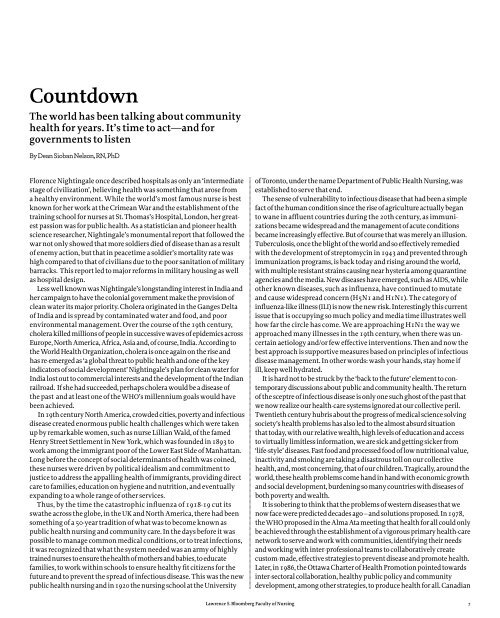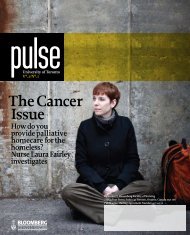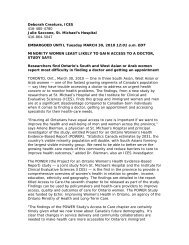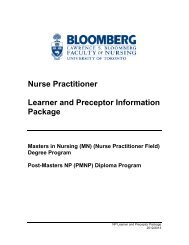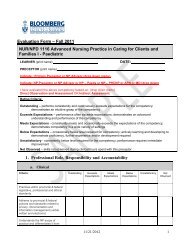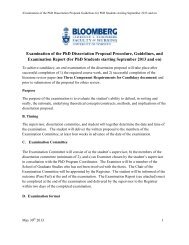Read more - Lawrence S. Bloomberg Faculty of Nursing - University ...
Read more - Lawrence S. Bloomberg Faculty of Nursing - University ...
Read more - Lawrence S. Bloomberg Faculty of Nursing - University ...
You also want an ePaper? Increase the reach of your titles
YUMPU automatically turns print PDFs into web optimized ePapers that Google loves.
CountdownThe world has been talking about communityhealth for years. It’s time to act—and forgovernments to listenBy Dean Sioban Nelson, RN, PhDFlorence Nightingale once described hospitals as only an ‘intermediatestage <strong>of</strong> civilization’, believing health was something that arose froma healthy environment. While the world’s most famous nurse is bestknown for her work at the Crimean War and the establishment <strong>of</strong> thetraining school for nurses at St. Thomas’s Hospital, London, her greatestpassion was for public health. As a statistician and pioneer healthscience researcher, Nightingale’s monumental report that followed thewar not only showed that <strong>more</strong> soldiers died <strong>of</strong> disease than as a result<strong>of</strong> enemy action, but that in peacetime a soldier’s mortality rate washigh compared to that <strong>of</strong> civilians due to the poor sanitation <strong>of</strong> militarybarracks. This report led to major reforms in military housing as wellas hospital design.Less well known was Nightingale’s longstanding interest in India andher campaign to have the colonial government make the provision <strong>of</strong>clean water its major priority. Cholera originated in the Ganges Delta<strong>of</strong> India and is spread by contaminated water and food, and poorenvironmental management. Over the course <strong>of</strong> the 19th century,cholera killed millions <strong>of</strong> people in successive waves <strong>of</strong> epidemics acrossEurope, North America, Africa, Asia and, <strong>of</strong> course, India. According tothe World Health Organization, cholera is once again on the rise andhas re-emerged as ‘a global threat to public health and one <strong>of</strong> the keyindicators <strong>of</strong> social development’ Nightingale’s plan for clean water forIndia lost out to commercial interests and the development <strong>of</strong> the Indianrailroad. If she had succeeded, perhaps cholera would be a disease <strong>of</strong>the past and at least one <strong>of</strong> the WHO’s millennium goals would havebeen achieved.In 19th century North America, crowded cities, poverty and infectiousdisease created enormous public health challenges which were takenup by remarkable women, such as nurse Lillian Wald, <strong>of</strong> the famedHenry Street Settlement in New York, which was founded in 1893 towork among the immigrant poor <strong>of</strong> the Lower East Side <strong>of</strong> Manhattan.Long before the concept <strong>of</strong> social determinants <strong>of</strong> health was coined,these nurses were driven by political idealism and commitment tojustice to address the appalling health <strong>of</strong> immigrants, providing directcare to families, education on hygiene and nutrition, and eventuallyexpanding to a whole range <strong>of</strong> other services.Thus, by the time the catastrophic influenza <strong>of</strong> 1918-19 cut itsswathe across the globe, in the UK and North America, there had beensomething <strong>of</strong> a 50-year tradition <strong>of</strong> what was to become known aspublic health nursing and community care. In the days before it waspossible to manage common medical conditions, or to treat infections,it was recognized that what the system needed was an army <strong>of</strong> highlytrained nurses to ensure the health <strong>of</strong> mothers and babies, to educatefamilies, to work within schools to ensure healthy fit citizens for thefuture and to prevent the spread <strong>of</strong> infectious disease. This was the newpublic health nursing and in 1920 the nursing school at the <strong>University</strong><strong>of</strong> Toronto, under the name Department <strong>of</strong> Public Health <strong>Nursing</strong>, wasestablished to serve that end.The sense <strong>of</strong> vulnerability to infectious disease that had been a simplefact <strong>of</strong> the human condition since the rise <strong>of</strong> agriculture actually beganto wane in affluent countries during the 20th century, as immunizationsbecame widespread and the management <strong>of</strong> acute conditionsbecame increasingly effective. But <strong>of</strong> course that was merely an illusion.Tuberculosis, once the blight <strong>of</strong> the world and so effectively remediedwith the development <strong>of</strong> streptomycin in 1943 and prevented throughimmunization programs, is back today and rising around the world,with multiple resistant strains causing near hysteria among quarantineagencies and the media. New diseases have emerged, such as AIDS, whileother known diseases, such as influenza, have continued to mutateand cause widespread concern (H5N1 and H1N1). The category <strong>of</strong>influenza-like illness (ILI) is now the new risk. Interestingly this currentissue that is occupying so much policy and media time illustrates wellhow far the circle has come. We are approaching H1N1 the way weapproached many illnesses in the 19th century, when there was uncertainaetiology and/or few effective interventions. Then and now thebest approach is supportive measures based on principles <strong>of</strong> infectiousdisease management. In other words: wash your hands, stay home ifill, keep well hydrated.It is hard not to be struck by the ‘back to the future’ element to contemporarydiscussions about public and community health. The return<strong>of</strong> the sceptre <strong>of</strong> infectious disease is only one such ghost <strong>of</strong> the past thatwe now realize our health-care systems ignored at our collective peril.Twentieth century hubris about the progress <strong>of</strong> medical science solvingsociety’s health problems has also led to the almost absurd situationthat today, with our relative wealth, high levels <strong>of</strong> education and accessto virtually limitless information, we are sick and getting sicker from‘life-style’ diseases. Fast food and processed food <strong>of</strong> low nutritional value,inactivity and smoking are taking a disastrous toll on our collectivehealth, and, most concerning, that <strong>of</strong> our children. Tragically, around theworld, these health problems come hand in hand with economic growthand social development, burdening so many countries with diseases <strong>of</strong>both poverty and wealth.It is sobering to think that the problems <strong>of</strong> western diseases that wenow face were predicted decades ago – and solutions proposed. In 1978,the WHO proposed in the Alma Ata meeting that health for all could onlybe achieved through the establishment <strong>of</strong> a vigorous primary health-carenetwork to serve and work with communities, identifying their needsand working with inter-pr<strong>of</strong>essional teams to collaboratively createcustom-made, effective strategies to prevent disease and promote health.Later, in 1986, the Ottawa Charter <strong>of</strong> Health Promotion pointed towardsinter-sectoral collaboration, healthy public policy and communitydevelopment, among other strategies, to produce health for all. Canadian<strong>Lawrence</strong> S. <strong>Bloomberg</strong> <strong>Faculty</strong> <strong>of</strong> <strong>Nursing</strong> 7


